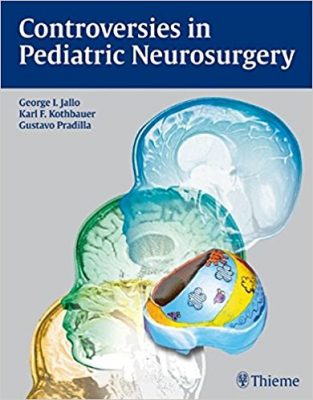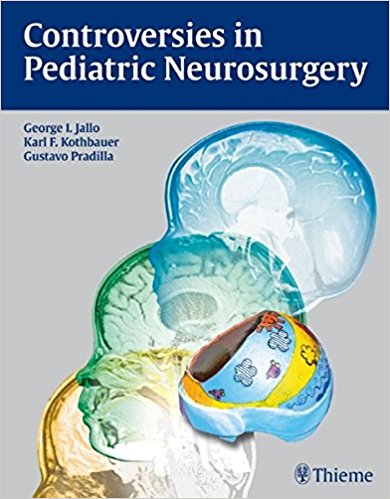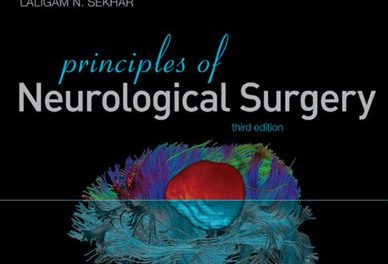 Editors: George I. Jallo, MD; Karl F. Kothbauer, MD; and Gustavo Padilla, MD
Editors: George I. Jallo, MD; Karl F. Kothbauer, MD; and Gustavo Padilla, MD
Publisher: Thieme – 263 pages
Book Review by: Nano Khilnani
Keeping an open mind about seeking the best solution to a patient’s problem that confronts any physician is the message that the editors of this book are conveying to the users of this book. It is described a ‘sensation of freedom’ by the Foreword author Concezio di Rocco, who mentions about “the editors’ willingness to deny a predetermined conclusion or appropriate answer for each given controversy” discussed in this book of controversies in pediatric neurosurgery.
For instance at the end of the first chapter entitled Arachnoid Cysts, the chapter authors Gabriel Zada and Mark D. Krieger write in the ‘Lessons Learned’ section that this type of cysts “are a superb example of how much our decisions parameters are influenced by certain preformed concepts. Most of us have a strong preference to avoid shunts, as we are all experiencing the downsides of shunting with those patients who continue to come back with the next shunt malfunction.”
Arachnoid cysts are clusters of cerebrospinal fluid (CSF) covered by arachnoidal cells and collagen. That may develop between the surface of the brain and the cranial base or on the arachnoid membrane, one of three meningeal layers that cover the brain and the spinal cord. Some babies are born with them, so they are usually a congenital disorder, but some are acquired, as have been reported in humans, cats, and dogs.
They are “developmental anomalies occurring between layers of the arachnoid membrane that are frequently encountered in pediatric patients,” as Drs Zada and Krieger describe at the beginning of the chapter.
Some of the signs and symptoms of someone having an arachnoid cyst are:
- Cranial deformation (macrocephaly)
- Bobble-head doll syndrome, with cysts in the suprasellar region
- Attention Deficit Hyperactivity Disorder (ADHD) with cysts in the middle cranial fossa.
- Headaches, found in studies involving a small number of children with arachnoid cysts
- Delays in development of the brain
There are basically two ways to deal with this type of anomaly – shunting and fenestration. Which is the better procedure to use in dealing with arachnoid cysts? Each option has its benefits and advantages. Read this chapter to get your detailed answers. Other chapters deal with other controversies in the field of neurosurgeries on children,
Seventy-four specialists in neurosurgery, oncology, pediatrics, pediatric neurosurgery, pediatric plastic surgery, radiation oncology, radiology, and interventional radiology – from all over the United States and eight other countries – Australia, Canada, England, Germany, Greece, Israel, Switzerland, Turkey – contributed content for this book by writing its 20 chapters, listed below to provide you and overview of what you will find in it:
- Intracranial
- Arachnid Cysts
- Communicating Hydrocephalus
- Noncommunicating Hydrocephalus
- Compartmentalized Hydrocephalus
- Slit Ventricle Syndrome
- Craniopharyngioma
- Optic Pathway / Hypothalamic Gliomas
- Ependymomas
- Scaphocephaly / Sagittal Synostosis
- Deformational Plagiocephaly
- Intracranial Suppuration
- Chiari Malformations
- Intractable Epilepsy
- Moyamoya Disease
- Pediatric Aneurysms
- Intraspinal
- Myelomeningocele
- Lipomyelomeningocele / Tethered Cord
- Intermedullary Spinal Cord Tumors
- Spasticity
- Syringomelia
Brain and spinal cord tumors are the second most common cancers among children (after leukemia) according to the American Cancer Society. More than 4,000 central nervous system tumors are diagnosed each year in children and teens.
Among the deadliest of neurologic tumors affecting children is glioblastoma, with only about one of every five of those afflicted with it surviving it five years after being diagnosed with it. This is classified among intramedullary spinal cord tumors (IMSCTs) discussed in chapter 18 of this book authored by Donald J. Blaskiewicz and Mark R. Proctor.
The second most deadly neurologic tumor among children is anaplastic astrocytoma with only a 30 percent survival rate after five years. This particular type of tumor is also covered in the same chapter. There are also controversies on the best way to treat IMSCTs.
Some surgeons prefer an aggressive surgical resection (gross total resection or subtotal resection) with technological advances in diagnoses impelling them to take this approach. What are some of these advances? They are neuro-imaging, microsurgical techniques, neurophysiologic monitoring, and better operative equipment.
But the risk of morbidity associated with aggressive surgical resection remains substantial, and has not been validated with data on survival curves and functional outcomes scales when compared with less aggressive options such as biopsies for tissue analysis, along with adjuvant radiotherapy and / or chemotherapy.
An interesting feature of this chapter to look at is Table 18.1 – Modified McCormick Scale for Functional Evaluation of Patients with Intramedullary Spinal Cord Tumors. It provides five grades of functionality of patients. The topmost Grade I is described as “neurologically intact, ambulates normally, may have minimal dyesthesia” to the bottom Grade V characterized as “paraplegia or quadriplegia, even if there is flickering movement”.
The editors and authors of this book of controversies do adhere to the positive value of keeping an open mind when confronted with confusing and sometimes conflicti0ng options on what to do to best treat children with neurologic problems.
They understand the importance of constantly seeking facts and data that either support their inclination to take a certain course of action, or oppose it. It has often been said that learning never ends and this book is an excellent example of this precept.
Editors:
George I. Jallo, MD is Associate Professor in the Division of Neurosurgery, Pediatrics and Oncology, Clinical Director in the Division of Pediatric Neurosurgery, and Clinical Director of the Neurosurgery Residency Program at Johns Hopkins Hospital in Baltimore, Maryland.
Karl F. Kothbauer, MD is Chief of the Division of Neurosurgery in the Department of Surgery, General and Pediatric Neurosurgery at Lucerne Cantonal Hospital in Lucerne, Switzerland.
Gustavo Padilla, MD is a Resident in the Department of Neurosurgery at Johns Hopkins Hospital in Baltimore, Maryland.






